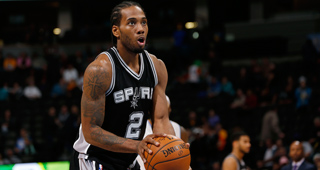Results always come before aesthetics in sports. The San Antonio Spurs were always thought of having bad aesthetics until their sheer longevity and the evolution of their offense into a brilliant choreography of movement, space, precision and high-level efficiency changed the way we regard them in this current iteration of their dynasty. Over time, they became the very definition of a cult classic.
A first round exit by the Spurs is now lamented as a loss of art whereas in the past we felt deprived of seeing the SSoL Suns or the pre-2011 Mavericks finally get over the hump to The Finals. The Golden State Warriors won the Finals, but there’s an unmistakable sense they dodged their most formidable challenger in the Spurs. And that challenger just got a whole lot better.
When you run an offense of movement involving all five players on the floor that perennially finishes in the top-10 in points per 100 possessions, a classic volume scorer becomes less imperative over an 82-game season. The Spurs run a side pick-and-roll that acts as a domino for their passing that will eventually find an open high efficiency shot. The rule of the NBA land is that you need a superhuman individual scorer to preside over an offense, but when you have ball movement and everyone on the court is an offensive threat, a team without that type of scorer is no longer an incomplete title contender.
The offensive greatness of James Harden, Kevin Durant and Carmelo Anthony are what we've defined as the single most valuable skill on the basketball floor for non-big men because they can score like Michael Jordan, but their defense doesn’t match what Jordan provided on that end of the floor at his peak. These great scorers understandably need to give up something on the defensive end of the floor to sustain themselves to carryout their exceptional skill on offense.
Kawhi Leonard represents a potentially momentous shift in that he doesn’t possess the typical characteristics of a top-10 player in the league. Leonard will never finish in the top-5 in scoring or protect the rim, but he can defend four positions and contributes enough in aggregate on offense to be extraordinarily impactful. Leonard of course defends both wings better than he can a point guard like Chris Paul or power forward like Blake Griffin as the Clippers’ series showed when he instead was largely assigned to J.J. Redick. Leonard as the best wing defender in the NBA largely speaks for itself, especially in beating Durant and LeBron James in consecutive series last year. In his Defensive Player of the Year season, the Spurs were more than five points per 100 possessions better with Leonard.
Rim protection is the single most important and rarefied defensive skill, but the disorientation Leonard induces in an opponents’ offense is similarly invaluable.
Even in the future when Leonard’s offensive potential is fully formed, it is doubtful he can become a high usage, 25 points per game scorer. Leonard’s final three games in the Clippers’ series saw him shoot 5-for-16, 3-for-15 and 5-for-13 from the field. Leonard certainly can’t create his own offense at will and is significantly better when his scoring quietly comes from within the flow of the Spurs’ offense than the isolations and post-ups that have become more common as Gregg Popovich gives him more license.
Leonard was their best player and won Finals MVP on the shoulders of the Spurs’ infrastructure (or “system” as Durant likes to call it), but he’ll need to continue taking a bigger role on offense as he improves and the old guard retires. Like the pick-and-roll, Leonard’s isolations are about forcing rotations out of mismatches that lead to open shots than for Leonard to necessarily score as the end result.
For the past decade, Carmelo elicited divisive opinions at the small forward position because he was a brilliant individual scorer and good rebounder for his position, but his defense and ability to create for others was always lacking. The advanced analytics community downplayed the strength his gravity and the eyetest perhaps overstated the difficulty of the way he scored.
Leonard will never truly compare to Carmelo as a pure scorer, but an 85 percent facsimile makes him the best player on the floor nearly every night of the season. Leonard had a True Shooting Percentage over .600 in March and April this season with an uptick in usage as he returned from injury. The secret on Leonard is that he’s one of the NBA’s truly elite mid-range shooters and he has also become a substantially better ballhandler and passer.
And that brings us to LaMarcus Aldridge, who is also a mid-range superstar in this era of three-pointers, dunks/layups and free throws. The Spurs waited on extending Leonard last offseason to maintain flexibility in pursuing a max contract free agent and if the strategy is successful, Aldridge is his likeliest running mate for the next five-plus years. Aldridge turns 30 this month and Leonard just turned 24. Because of how each of their games should age, the remainder of their primes should sync up fairly closely.
A combination of Leonard and Aldridge operating in that mid-range basically becomes the next evolution of how to run an efficient NBA offense. These shots by themselves, even as well as Leonard and Aldridge shoot it, aren’t efficient in themselves but they draw gravity to the middle of the floor and create the types of open looks that have become routine for the Spurs and Blazers.
Leonard and Aldridge gives the Spurs the ability to match-up as well against big lineups with them at the three and four as it would against pace and space small lineups with them at the four and five.
Leonard carrying the Spurs’ offense would have been a big ask, but getting to grow his scoring and playmaking beside Aldridge allows him to continue to play to his strengths and become the fully formed version of what his potential has shown over these past two remarkable years. Beyond the mere benefit of adding a player of Aldridge’s talents to a team already competing for a title, the greatest impact of his signing is how it elevates the ceiling of Leonard.
The special relationship the Spurs cultivate with their players makes this happen. San Antonio has routinely been able to get their key players to take less money, or merely trust the process as Leonard did in delaying his extension until this summer so they can keep his low cap hold to fit in Aldridge.
The Spurs were already winning the offseason with paintball and party buses; signing Aldridge to join forces with Leonard sets up another reload. To add Aldridge while also somehow keeping Danny Green on a four-year, $45 million contract makes this an all-time great offseason in NBA history. Life without Duncan and Popovich was a harrowing possibility for the Spurs, but they’re now set to remain perennial title contenders for the remainder of this decade and beyond the careers of those two NBA legends.



